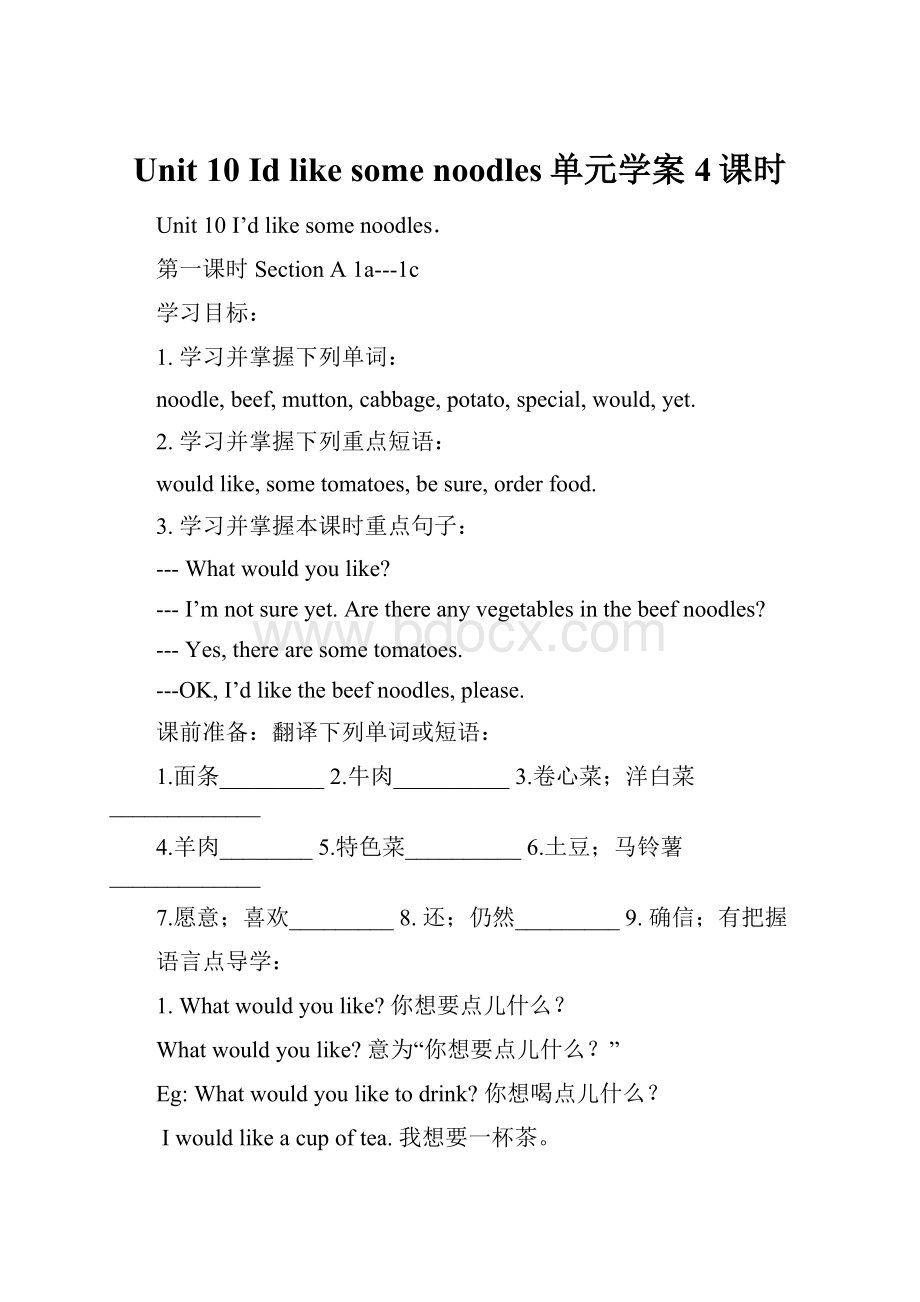 Unit 10 Id like some noodles单元学案 4课时.docx
Unit 10 Id like some noodles单元学案 4课时.docx
- 文档编号:27449575
- 上传时间:2023-07-01
- 格式:DOCX
- 页数:12
- 大小:20.73KB
Unit 10 Id like some noodles单元学案 4课时.docx
《Unit 10 Id like some noodles单元学案 4课时.docx》由会员分享,可在线阅读,更多相关《Unit 10 Id like some noodles单元学案 4课时.docx(12页珍藏版)》请在冰豆网上搜索。

Unit10Idlikesomenoodles单元学案4课时
Unit10I’dlikesomenoodles.
第一课时SectionA1a---1c
学习目标:
1.学习并掌握下列单词:
noodle,beef,mutton,cabbage,potato,special,would,yet.
2.学习并掌握下列重点短语:
wouldlike,sometomatoes,besure,orderfood.
3.学习并掌握本课时重点句子:
---Whatwouldyoulike?
---I’mnotsureyet.Arethereanyvegetablesinthebeefnoodles?
---Yes,therearesometomatoes.
---OK,I’dlikethebeefnoodles,please.
课前准备:
翻译下列单词或短语:
1.面条_________2.牛肉__________3.卷心菜;洋白菜_____________
4.羊肉________5.特色菜__________6.土豆;马铃薯_____________
7.愿意;喜欢_________8.还;仍然_________9.确信;有把握
语言点导学:
1.Whatwouldyoulike?
你想要点儿什么?
Whatwouldyoulike?
意为“你想要点儿什么?
”
Eg:
Whatwouldyouliketodrink?
你想喝点儿什么?
Iwouldlikeacupoftea.我想要一杯茶。
Whatwouldyoulike?
的常用答语为:
Iwouldlike…“我想要……”,注意Iwould还可缩写为I’d。
eg:
---Whatwouldyoulike?
你想要点儿什么?
---I’dlikeacupoftea.我想要一杯茶。
注意:
wouldlike意为“想要”,wouldlike与动词want同义,表示意愿,语气比want更委婉、更礼貌;wouldlike可与任何人称连用,没有人称和数的变化,其后常跟名词、代词或动词不定式做宾语。
变否定句是在would后加not。
变一般疑问句时将would移至句首,同时注意含有wouldlike的一般疑问句中的some不变any,表示说话人希望得到对方的肯定回答。
wouldlike常用的句型:
(1)wouldlikesth想要某物。
(2)wouldliketodosth.想要做某事。
(3)wouldlikesb.todosth.想要某人做某事(4)Wouldyoulikesth.?
肯定回答:
Yes,please.否定回答:
No,thanks.(5)Wouldyouliketodosth.?
肯定回答:
Yes,I’dlove/liketo(to不能省去)否定回答:
I’dloveto,but+原因。
/Sorry,I’mafraidnot,Ihaveto…
eg:
---Wouldyoulikesomewater?
---Yes,please./No,thanks.
---Wouldyouliketogothere?
---Yes,I’dlove/liketo.
---Wouldyouliketogowithme?
你愿意和我一起去吗?
---Yes,I’dlike/loveto.是的,我愿意。
---I’dlike/loveto,butI’mbusy.我愿意,但我很忙。
2.I’mnotsureyet.我还不确定。
yet做副词,用于否定句中,意为“还,仍然”,用于疑问句中意为“已经”,yet通常位于句末。
eg:
Iamnotreadyyet.我还没有准备好。
课堂跟踪练习:
根据句意及首字母提示填单词:
1.I’dlikesomen.
2.Shelikeseatingb.Sheisstrong(强壮的)。
3.Tomdoesn’tgivemethebooky.
4..Dumplings(饺子馆),wehavesomegreats.
课后巩固练习:
一、用所给单词的正确形式填空:
1.Therearesome_________(tomato)onthetable.
2.I’dlike_______(go)shopping.
3.Jackis_______(luck)togothere.
4.Shewantstobuy________(sport)shoes.
5.Those_____(man)areverykind.
6.Theywouldlike_______(see)theanimalsinthezoo.
二、单项选择:
()1.---Wouldyoulikesomethingtoeat?
---_______.
A.Yes,IwouldB.No,Iwouldn’t
C.No,Idon’tD.No,thanks
()2.Wouldyoulikemutton?
A.someB.anyC.aD.many
()3.Wouldyouliketogotothemovie?
A.Yes,I’dloveto.B.Yes,please.C.Yes,I’dloveD.No,thanks.
()4.I’dlikeabook.
A.readB.toreadC.readingD.tolook
()5.JuliewouldlikeTV.
A.watchB.watchesC.watchingD.towatch
课后记:
Unit10I’dlikesomenoodles.
第二课时SectionA2a---3c
学习目标:
1.学习并掌握下列单词:
large,order,size,bowl,tofu,meat.
2.学习并掌握下列重点短语:
whatsize,one(large)bowlof…,takeone’sorder
3.学习并掌握本课时重点句子:
---MayItakeyourorder?
---Yes.
---Whatkindofnoodleswouldyoulike?
---I’dlikebeefnoodles,please.
---Whatsizewouldyoulike?
---I’dlikealargebowl,please.
---Isthereanymeatinthetomatoandeggsoup?
---No,there’snomeat.
课前准备:
翻译下列短语和句子:
1.MayItakeyourorder?
_______________
2.beefsoup__________
3.onebowlofbeefsoup______________
4.wouldlike___________
5.Whatkindofnoodleswouldyoulike?
________________________
6.Whatsizewouldyoulike?
______________________
7.Whatkindofnoodlesdoyouhave?
______________________4.AttheHouseof
语言点导学:
1.MayItakeyourorder?
可以点菜了吗?
MayI…?
表示“请求,许可”
肯定回答:
Yes,youmay.否定回答:
No,youmustn’t/youcan’t.
eg:
MayItakesomephotosinthehall?
No,youmustn’t
order在本句中做名词,意为“预定,点菜”。
takeone’sorder意为“准备点菜”,是点菜时服务员的常用语。
2.Whatsizewouldyoulike?
你想要多大碗的?
Whatsize…?
询问大小,意为“多大的……;多大尺寸的……;多大号码的……”。
size为名词,表示“尺寸,大小,号码”等。
数字跟在size后。
eg:
---Whatsizeshoeswouldyoulike?
你要多大号的鞋子?
---I’dlikesize40.我要40码的。
3.Whatkindofnoodleswouldyoulike?
你要什么面条?
“Whatkindof+名词+wouldyoulike?
”意为“你想要哪一种……?
”,常用来询问某人想要某种类型的东西。
其中kind为名词“种类”。
句中的名词为可数名词时要用复数形式。
eg:
Whatkindoffoodwouldyoulike?
你想要哪种食物?
Whatkindofvegetableswouldyoulike?
你想要哪种蔬菜?
拓展:
kind做名词的用法:
kind做名词时意为“种类”,表示“一种……”要用akindof…;“各种各样的……”要用allkindsof….
课堂跟踪练习:
单项选择:
()1.---Whatkindofnoodleswouldyoulike?
---_______.
A.Alargebowl.B.Amediumbowl.
C.BeefnoodlesD.Yes,please.
()2.Doyoulikenoodleschicken?
A.withB.ofC.inD.to
()3.---Whatsizeshoesdoyouwant?
---_______.
A.SmallshoesB.Size36C.36sizeD.Bigshoes
()4.Mymotheroftengoestothesupermarkettobuysome___hamburgers.
A.tomatoesB.tomatosC.tomatoD.tomato’s
()5.---What____noodleswouldyoulike?
---I’dlikeamediumbowl.
A.sizeB.sizebowlC.sizebowlofD.kindof
()6.---Idon’tlikemuttonbeef.
---Idon’tlikemutton,Ilikebeefalot.
A.and,butB.and,andC.or,butD.or,and
()7.Andrewusuallyhasfruit____dinner.
A.ofB.forC.atD.with
()8.Howmucharethe_____?
A.potatoB.potatosC.potatoesD.potato’s
()9.Theyhavetwobowlsofnoodles.
A.tomatoandeggB.tomatoandeggs
C.tomatoesandeggD.tomatoesandegg
()10.—MayIsmokehere?
---Sorry,you______.Lookatthesign“Nosmoking.”
A.canB.maynotC.mustn’tD.needn’’t
课后记:
Unit10I’dlikesomenoodles.
第三课时SectionB1a—1d
学习目标:
1.学习并掌握下列单词:
dumpling,porridge,onion,fish,pancake,
2.学习并掌握下列重点短语:
matchwith,greentea,orangejuice,completetheform,telephonenumber.aroundtheworld,
3.学习并掌握本课时重点句子:
---Ilikedumplings,fishandorangejuice.
---Idon’tlikeonions,greenteaorporridge.
课前准备:
根据句意及首字母填空:
1.Myfavoritedrinkisorangej______________.
2.JohnlikesChinesefood.Helikestoeatd_________verymuch.
3.Wouldyoulikegreent_________?
4.Whats_______shoesdoyouwant?
5.I’dlikeab__________ofnoodles.
语言点导学:
1.---Ilikedumplings,fishandorangejuice.我喜欢水饺、鱼和橘汁。
“fish”作可数名词,意为“鱼、鱼类”。
作不可数名词,意为“鱼肉”。
eg:
Therearemanyfishesinthepool.(可数)Iwanttoeatsomefish.(不可数)“orange”作可数名词,意为“桔子”。
作不可数名词,意为“桔子汁”。
作形容词为“橘黄色的”.eg:
Isthereanyorangeinthebottle(瓶子)?
Iwanttoeatanorange.Thisisanorangecoat.
2.Idon’tlikeonions,greenteaorporridge.我不喜欢洋葱,绿茶和粥。
(1)and和or都表示“和,与”。
and一般用于肯定句中,连接两个或多个并列成分。
而or一般用于否定句中,连接两个或多个并列成分。
(2)or可以用于选择疑问句,表示“或者,还是”。
请用and或or填空:
①Ilikesinging______dancing.
②Theboydoesn’tlikesinging_____dancing.
③---Doyoulikesinging_____dancing?
---Dancing.
课堂跟踪练习:
单项选择:
()1.---Wouldyoulikesomeonions?
---______________.
A.Yes,IwouldB.No,Iwouldn’t
C.No,thanksD.Yes,youwould
()2.Thereisnobirdcatinthetree.
A.andB.orC.alsoD./
()3.Hewouldlike______intheroom.
A.liveB.livesC.toliveD.living
()4.Jimdoesn’tliketomatoes,potatoes______cabbage.
A.andB.withC.orD.for
()5.Theresomefoodonthetable.
A.isB.areC.hasD.have
课后巩固练习:
从下列句子中选择适当的选项,补全对话:
(W=Waiter,A=Annie)
W:
Hello,David’srestaurant!
A:
Hello,___1_____
W:
Sure.A:
_______2________
W:
Whatkindofhamburgerswouldyoulike?
A:
____3_____
A.I’dliketoordersomefood,please.
B.Doyouwantanydrinks?
C.Whatkindofhamburgersdoyouhave?
D.I’dlikesomehamburgers.
E.Thenwhat’syouraddress,please?
W:
Wehavebeef,
chickenandfruit.
A:
Beef,please.
W:
OK.____4__
A:
No,thanks.
W:
____5___
A:
65BridgeStreet.
课后记:
Unit10I’dlikesomenoodles.
第四课时SectionB2a—selfcheck
学习目标:
1.学习并掌握下列单词:
world,answer,different,cake,candle,age,blow,if,will,theUK,candy,lucky,popular,idea.
2.学习并掌握下列重点短语:
thenumberof,makeawish,blowout,cometrue,getpopular,cutup,bringgoodlucktosb.differentkindsof,beshortof,ordermuttonnoodles,puton,askfortheorder,askabout.
3.学习并掌握本课时重点句子:
---Wouldyoulike…?
---Wehave…for…
---Youcantryour…---…isverygood/delicious.
课前准备:
用所给词的正确形式填空:
1.Whatwouldshelike(eat)?
2.He(not)havehamburgers.
3.Ilikekoalasbecausetheyare(friend)andsmart.
4.Therearesome(photo)inthebook.
5.Ican(go)shoppingandnobody(know)me.
6.Theywouldlike____________(see)theanimalsinthezoo.
7.Howmany(dumpling)wouldyoulike?
8.I’dlike(go)shopping.
9.Therearesome________(tomato)and_______(porridge)onthetable.
翻译下列短语:
1.一些好的特色菜________________2.不同种类的水果_________________
3.抓住它___________________4.缺少鱼___________________
5.带上眼镜_________________6.要求点菜_________________
语言点导学:
1.Thebirthdaypersonmustmakeawishandblowoutthecandles.过生日的人必须许个愿望,并吹灭蜡烛。
makeawish意为“许一个愿”wish为名词“愿望”多指不太可能实现的愿望,而hope为“希望”,多指实现几率较大的愿望。
eg:
Shemakesawishonherbirthdayparty.她在生日派对上许了一个愿望。
Youmustn’tgiveupyourhope.你不能放弃希望。
2.Theybringgoodlucktothebirthdayperson.它们给过生日的人带来好运。
bring意为“带来,拿来”,常用结构为“bringsthtosb,相当于bringsbsth”意为把某物带给某人。
与take(拿走,带走)相反。
eg:
Canyoubringmycoattome?
你能把我的外套带来吗?
Hebringsmeanewcarmodel.他给我带来了一个新的汽车模型。
Pleasetakeyourbag.请把你的书包拿走。
Luck名词,“运气”lucky形容词,“幸运的”luckily副词,“幸运地”通常放在句首,“幸运的是”用来修饰整个句子。
eg:
Whataluckyguyyouare!
Goodlucktoyou!
Luckily,Wegotonthebusintime.
3.Thenumberofcandlesistheperson’sage.蜡烛的数目是人的年龄。
thenumberof意为“……的数量”,后跟可数名词复数,做主语时谓语动词
单数形式。
拓展:
Anumberof意为“许多”,后跟可数名词复数,做主语时谓语动词用复数形式。
eg:
Canyoutellmethenumberofstudents?
你能告诉我学生的数量吗?
Thenumberofstudentsinourclassis50.我们班学生的数量是50.
Anumberofstudentsinourclassworkhard.我们班许多学生学习努力。
4.Butweareshortoffish.但是我们缺少鱼。
beshortof为固定搭配,意为“缺少,短缺”。
反义词组为berichin有丰富的……;富于。
eg:
Weareshortofmoneynow.目前我们缺少钱。
5.Askfortheorder要求点餐。
askfor意为“请求,要求”为固定搭配。
后接名词做宾语。
eg:
Sheasksfortimetothinkthismatter.她要求给她时间来考虑这件事。
课堂跟踪练习:
一、单项选择:
()1.She’d________somebeefnoodlesforlunch.
A.likesB.likeC.haveD.has
()2.Wouldyoulikesome_____________ ?
A.
- 配套讲稿:
如PPT文件的首页显示word图标,表示该PPT已包含配套word讲稿。双击word图标可打开word文档。
- 特殊限制:
部分文档作品中含有的国旗、国徽等图片,仅作为作品整体效果示例展示,禁止商用。设计者仅对作品中独创性部分享有著作权。
- 关 键 词:
- Unit 10 Id like some noodles单元学案 4课时 noodles 单元 课时
 冰豆网所有资源均是用户自行上传分享,仅供网友学习交流,未经上传用户书面授权,请勿作他用。
冰豆网所有资源均是用户自行上传分享,仅供网友学习交流,未经上传用户书面授权,请勿作他用。


 《C12343098汽轮机操作规程》要点.docx
《C12343098汽轮机操作规程》要点.docx
 托盘堆码方式.pptx
托盘堆码方式.pptx
